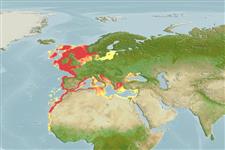Common names from other countries
分类 / Names
俗名 | 同种异名 | Catalog of Fishes(属, 种) | ITIS | CoL | WoRMS | Cloffa
Elasmobranchii
板鳃亚纲 (鲨鱼与 鱼) (sharks and rays) >
Carcharhiniformes (Ground sharks)
白眼鮫目 (Ground sharks) >
Scyliorhinidae (Cat sharks)
貓鮫科(Cat sharks) (Cat sharks) > Scyliorhininae
Etymology: Scyliorhinus: skylion, Greek for dogfish or small shark; rhinus, from rhine (Gr.), rasp, alluding to a shark’s jagged, rasp-like skin. (See ETYFish); canicula: Diminutive of canis (L.), dog; sharks were known as “sea dogs” and “dog-fishe” among mariners until the late 16th century, because of their ferocious pack-like feeding behavior. (See ETYFish).
More on author: Linnaeus.
Environment: milieu / climate zone / depth range / distribution range
生态学
海洋 居于水底的; 深度上下限 10 - 780 m (Ref. 56504), usually 80 - 100 m (Ref. 81056). 亞熱帶的; 63°N - 3°N, 32°W - 37°E
North Sea (sw coast of Sweden to Copenhagen, Denmark), Northeastern Atlantic Ocean (Ireland, United Kingdom, France, Portugal); Mediterranean Sea (Spain, France, Italy, Tunisia, Algeria, Morocco); nw Africa, close to the Strait of Gibraltar and to the north of Mauritania (20º30’N); including Norwegian Sea.
東北大西洋: 挪威與不列顛群島南至塞內加爾, 包括地中海。 可能地象牙海岸。 一些族群的差異在 Catulus duhameli(一個名稱對於以大小為依據的地中海 canicula) 與這種之間存在那可能最後被表示成亞種。 在克里米亞半島的水域的這種的唯一被報告的觀察在 1937 年, 是可能錯誤.(參考文獻 897)
Length at first maturity / 大小 / 重量 / 年龄
Maturity: Lm 50.0, range 35 - 64 cm
Max length : 100.0 cm TL 雄鱼/尚未辨别雌雄; (Ref. 244); common length : 60.0 cm TL 雄鱼/尚未辨别雌雄; (Ref. 4645); 最大体重: 3.7 kg (Ref. 128278); 最大年龄: 12 年 (Ref. 81067)
This species is distinguished from all its congeners by the following characters: shallow nasoral grooves and laterally situated posterior nasal flaps (vs. no grooves and posterior flaps on the posterior border of the excurrent apertures in congeners, except in S. duhamelii); distance between the anterior nasal flaps 6-7.5 times smaller than the anterior nasal flap width (vs. 3.5-5 times smaller in S. duhamelii; two times in the other species); lower labial furrow 2.1-2.2 times smaller than mouth width (vs. more than 3 times in other species, except S. duhamelii). Colouration: color pattern with dark spots well-defined, predominantly smaller than spiracles (vs. no dark spots in S. capensis, S. comoroensis, S. hesperius, S. meadi, S. torazame, S. torrei; reticulated pattern in S. rotifer; dark spots predominantly larger than spiracles in S. cervigoni, S. garmani, S. haeckelii, S. stellaris; diffuse spots in S. duhamelii); clasper with rough terminal dermal cover (also found only in S. capensis) (Ref. 120402).
一个细长又有深色斑点的猫鲨具有大量扩大前鼻瓣, 达到嘴与覆盖浅鼻沟, 唇沟只在下颌上, 第二背鳍鳍远小于第一个 (参考文献 244)
Most common catshark in coastal waters of Europe (Ref. 32804). Inhabits continental shelves and uppermost slopes. Found on sandy, coralline, algal, gravel or muddy bottoms. Occurs mainly between 10-100 m depth in the northeast Atlantic and up to 400 m depth in the Mediterranean Sea (Ref. 88187) and from 288-780 m in the eastern Ionian Sea (Ref. 56504). They sometimes occur in midwater. Nocturnal species, males resting on substrate and females hiding in shallow (0.5-1.5 m depth) caves and crevices during the day (Ref. 88835). Feed on a variety of benthic invertebrates, including mollusks, crustaceans, small cephalopods, polychaete worms, and small bony fishes (Ref. 244, 11889). Males have been found to forage in shallow prey-rich areas with soft sediment or areas covered with filamentous algae (Ref. 88836). Oviparous, with a single egg laid per oviduct at a time. Detect weak electric fields generated by other organisms (e.g. potential prey) (Ref. 10311). Utilized fresh and dried-salted for human consumption, also for oil and fishmeal.
栖息于大陆棚与最上面的斜坡。 来自 10- 的深度范围 400 公尺 (参考文献 244), 与从 288-780 在爱奥尼亚的海洋东部中.(参考文献 56504) 栖息于了沙的﹐珊瑚的﹐和海藻的, 砾石或者泥底部深度几公尺通常向下至 110 公尺。 有时出现在中层水域。 捕食软件动物与甲壳动物,小的头足类动物,多毛类的蠕虫与小的硬骨鱼类。 卵生的, 每个输卵管只有一个卵一次。 生鲜使用与干燥盐腌供人类消费, 也用做鱼油与鱼粉。
Oviparous, laying paired eggs (one per oviduct) in shallow subtidal areas, although some egg cases have been found in the deeper part of intertidal zones (Ref. 244). Embryos feed solely on yolk (Ref. 50449). The egg cases are anchored to macroalgae, sea grass or sessile erect invertebrates such as poriferans, bryozoans and hydroids (Ref. 32804, 58137). The capsules have tendrils at each corner used for anchorage purposes. Egg capsule size varies according to locality and female size (Ref. 244) and ranges between 4.9-7.0 cm length and 1.5-3.0 cm width (Ref. 88837). Egg cases may be deposited throughout the year, peaking in June and July (Ref. 32804). Recent studies estimate fecundity of females from the northeast Atlantic to be at around 29-62 pups (Ref. 32804). Fully formed pups hatch after 5-11 months, depending on water temperature (Ref. 244, 32804). Newly hatched pups are about 8-10 cm in length (Ref. 78469).
東北大西洋: 挪威與不列顛群島南至塞內加爾, 包括地中海。 可能地象牙海岸。 一些族群的差異在 Catulus duhameli(一個名稱對於以大小為依據的地中海 canicula) 與這種之間存在那可能最後被表示成亞種。 在克里米亞半島的水域的這種的唯一被報告的觀察在 1937 年, 是可能錯誤.(參考文獻 897)
Soares, K.D.A. and M.R. De Carvalho, 2019. The catshark genus Scyliorhinus (Chondrichthyes: Carcharhiniformes: Scyliorhinidae): taxonomy, morphology and distribution. Zootaxa 4601(1):1-147. (Ref. 120402)
CITES (Ref. 128078)
Not Evaluated
人类利用
渔业: 低经济
工具
特别资料
下载 XML
网络资源
Estimates based on models
Preferred temperature (Ref.
115969): 7.2 - 16.2, mean 10.1 (based on 28 cells).
Phylogenetic diversity index (Ref.
82804): PD
50 = 0.5000 [Uniqueness, from 0.5 = low to 2.0 = high].
Bayesian length-weight: a=0.00148 (0.00126 - 0.00174), b=3.20 (3.15 - 3.25), in cm Total Length, based on LWR estimates for this species (Ref.
93245).
营养阶层 (Ref.
69278): 3.8 ±0.3 se; based on diet studies.
回复力 (Ref.
120179): 低的, 最小族群倍增时间4.5 - 14 年 (K=0.20; tm=9; Fec=96).
Prior r = 0.35, 95% CL = 0.23 - 0.53, Based on 1 full stock assessment.
Fishing Vulnerability (Ref.
59153): High vulnerability (59 of 100).
Climate Vulnerability (Ref.
125649): Moderate to high vulnerability (53 of 100).
